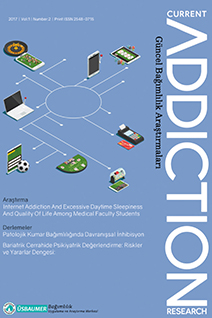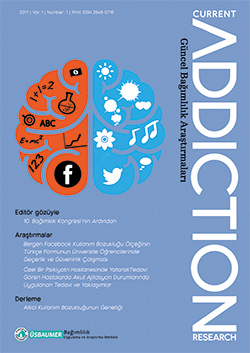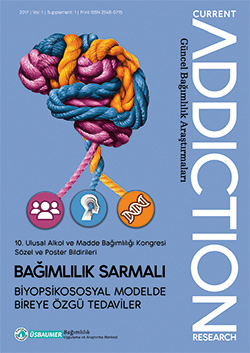Years
2018
Categories
Authors
ARTICLES
Original Article
Evaluation of Memory Functions of Alcohol Dependent Patients
Serdar Nurmedov
2018, 2(1), s:5-10
Long-term alcohol use causes varying degrees of deficit in various cognitive functions including learning, memory, visuospatial functions and abstraction. Studies using different techniques indicate that the neocortex, particularly the frontal lobe; limbic system and cerebellum are the brain regions most vulnerable to the toxic effects of alcohol.
The aim of this study is to assess the memory function in individuals with a history of alcohol dependency who meet the criteria for at least early partial remission and to compare it with healthy controls. The study also aims to investigate the association of memory function with duration of abstinence.
Twenty-four patients and 24 age, sex and education matched healthy controls were included in the study. Patients with Axis-I comorbidity, chronic neurological disease, dementia, chronic disease, Wernicke encephalopathy, Korsakoff syndrome and history of head trauma were excluded. The memory function of alcohol dependent individuals and healthy controls was assessed with Wechsler Memory Scale (WMS) and Rey Auditory- Verbal Learning Test (AVLT).
The memory subscales that show significant difference between the dependent and control groups are immediate memory span, total scores of learning trials and learning false score in AVLT and forward digit span, backward digit span, visual reproduction and memory quotient in WMS. Statistically significant difference was found in the long term recall score and long term false recognition score between the early and sustained full remission subgroups.
As a result of this study, dependent subjects are found to show more deficit in attention and memory functions compared to healthy controls. These findings are consistent with the literature on this subject.
Original Article
Sociodemographic Examination of Patients Applying to Probation Policlinic in Erzurum Province
Fatma Eren,Nermin Gündüz,Hatice Turan,Erkal Erzincan
2018, 2(1), s:11-16
Objective: In this first study on the patients who applied to the Probation Ward in the Eastern Anatolian Region of Erzurum province, it is aimed to compare the sociodemographic data of the patients with the substance use characteristics and other legal crimes.
Method: Between December 2015 and February 2016, 132 patients who applied for the first time to the Erzurum DS polyclinic were included in the study. The sociodemographic data form prepared by the researchers participating in the research was applied.
Results: All of the 132 cases involved in the study were men. While 49.2% of the patients had multiple substance use, cannabis was found to be the highest substance alone at 45.4% level. We found that smoking and alcohol use started earlier than substance use and that alcohol and cigarette use were high. Considering the impact of multiple substance use on the sociodemographic data, a significant difference was found between early substance use age, substance abuse existence in the past month, the first cigarette smoking age, self-harm behavior presence, the existence of additional criminal cases and the existence of previous psychiatric treatment history. There was a significant positive correlation between the age of first substance use and the age, the age of first cigarette use and the age of first alcohol use. Finally, when the groups with and without prison stories are compared in terms of self-harm behavior, a significant difference was found.
Conclusion: Reviewing the sociodemographic data of individuals with probation application will guide clinicians in defining the group in which more preventive measures will be taken for substance use.
Original Article
The Comparison of The Theory of Mind in Internet Addicted And Non-Addicted University Students
Nuran Korkmaz,Hızlı Sayar Gökben,Hüseyin Ünübol,Nevzat Tarhan
2018, 2(1), s:17-21
Aim: The purpose of this study is to compare the university students having diagnosed as internet addicted and internet non-addicted in terms of the theory of mind.
Methods: The study group consisted 50 undergraduate students at Üsküdar University. 25 students diagnosed an internet addicted composed the study group. 25 students who have same sex with the study group subjects, however do not have any internet addiction, composed the study group.
Results: The average age of the students is 22.74±1.45. Data was collected by using sociodemographic data form, Internet Addiction Scale and the Dokuz Eylül Theory of Mind Scale. The study group found to have statistically significantly lower scores in theory of Mind Scale, when compared to the control group.
Conclusion: This result suggests that internet addiction may affect the students’ social interaction, emotional and cognitive processing.
Case Report
Respiratory Depression caused by Buprenorphine and Benzodiazepine Use
Hasan Kaya,Bolat Kaya Özlem,Cihat Paltun Salih
2018, 2(1), s:22-26
Buprenorphine is a semi-synthetic opioid derived from thebaine. It is used for analgesic effect and opioid substitution therapy. In Turkey, buprenorphine and naloxone combination (Suboxone®) has been used in opioid substitution therapy since 2010. In this paper respiratory depression arising after buprenorphine use together with benzodiazepine will be told and possible mechanisms of this interaction will be discussed.
Case Report
Primary-Secondary Differentiation of Substance Use Disorders and Psychosis Association: Case Report
Işıl Göğcegöz,Fagan Zakirov
2018, 2(1), s:27-30
Psychoactive substance use disorder can be defined as a chronic illness with an uncontrollable impulsivity to drug use by affecting reward, motivation, memory and decision making mechanisms in individuals brains. These substances can cause dangerous consequences in the lives of individuals by causing addiction and, on the other hand, by stimulating or depressing the central nervous system, causing mood, mental state, behavioral and motor function disorders. Caffeine, hallucinogens, lysergic acid diethylamide (LSD), inhalants, nicotine, phencyclidine, sedatives, hypnotics, anxiolytics, anabolic steroids, nitrous oxide are among the addictive substances (1 ,2). The incidence of psychiatric disorders in patients with substance use disorders is 2.7 times higher. It has been reported that 70-75% of individuals with substance use disorders are accompanied by at least one psychiatric disorder (2,3). It is also known that substance abuse is more common in psychiatric disorders. In a study conducted in Turkey psychoactive substance use in schizophrenia 3.2%, while bipolar disorder is reported to be 3.5%. In the same study, 39% of the patients who received substance abuse and inpatient treatment received psychotic disorder and 23% received bipolar disorder (4).
Very common psychotic disorder or comorbid condition among substance use related disorders is clinically important. One of the biggest challenges faced by clinicians in this case is the primary-secondary distinction (5). In this study, psychoactive substance use and psychosis association and primary-secondary distinction are discussed through two case studies.



 2. Sayı
2. Sayı
 1. Sayı
1. Sayı
 Ek Sayı
Ek Sayı







